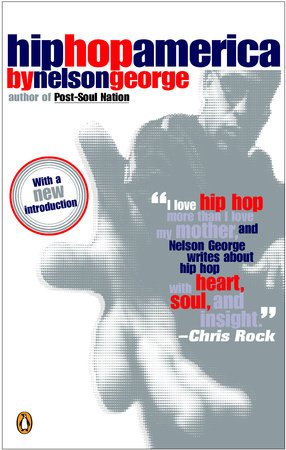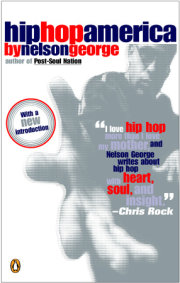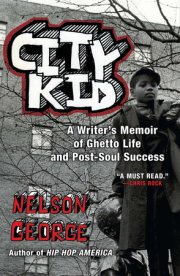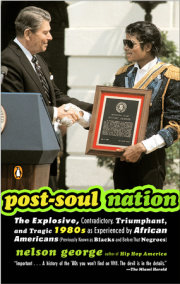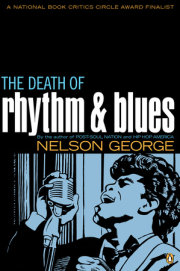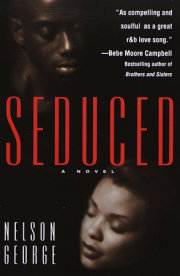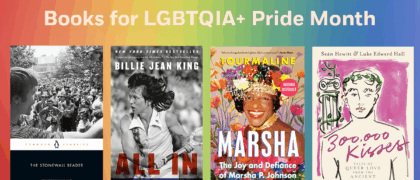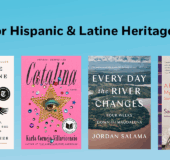Table of Contents
Title Page
Dedication
Copyright Page
Introduction
chapter 1 - post-soul
chapter 2 - hip hop wasn’t just another date
chapter 3 - gangsters—real and unreal
chapter 4 - the “i” of me
chapter 5 - black owned?
chapter 8 - the permanent business
chapter 7 - sample this
chapter 8 - where my eyes can see
chapter 9 - new jack swing to ghetto glamour
chapter 10 - national music
chapter 11 - the sound of philadelphia—dunking
chapter 12 - capitalist tool
chapter 13 - too live
chapter 14 - skills to pay the bills
chapter 15 - funk the world
chapter 16 - “da joint!” and beyond
chapter 17 - we ain’t goin’ nowhere: twenty-first-century bling
sources / further reading
Acknowledgements
index
FOR MORE WORKS BY NELSON GEORGE, LOOK FOR THE
FOR THE BEST IN PAPERBACKS, LOOK FOR THE
PENGUIN BOOKS
HIP HOP AMERICA
Nelson George is the author of ten nonfiction books on African-American culture and of four novels. He has received two ASCAP-Deems Taylor Awards, a Grammy, and two American Book Awards from the Before Columbus Foundation for Hip Hop America and Elevating the Game. Hip Hop America and The Death of Rhythm & Blues were also finalists for the National Book Critics Circle Award. He has written for national magazines, including Playboy, Billboard, Esquire, Spin, Essence, and The Village Voice, and has written and produced several television programs as well as two feature films. His new film Everyday People recently premiered on HBO. He was born in Brooklyn, New York, where he still lives.
for my family
PENGUIN BOOKS
Published by the Penguin Group
Penguin Group (USA) Inc., 375 Hudson Street, New York, New York 10014, U.S.A.
Penguin Group (Canada), 10 Alcorn Avenue, Toronto, Ontario, Canada M4V 3B2
(a division of Pearson Penguin Canada Inc.)
Penguin Books Ltd, 80 Strand, London WC2R 0RL, England
Penguin Ireland, 25 St Stephen’s Green, Dublin 2, Ireland (a division of Penguin Books Ltd)
Penguin Group (Australia), 250 Camberwell Road, Camberwell, Victoria 3124, Australia
(a division of Pearson Australia Group Pty Ltd)
Penguin Books India Pvt Ltd, II Community Centre, Panchsheel Park, New Delhi—110 017, India
Penguin Group (NZ), cnr Airborne and Rosedale Roads, Albany, Auckland 1310, New Zealand
(a division of Pearson New Zealand Ltd)
Penguin Books (South Africa) (Pty) Ltd, 24 Sturdee Avenue, Rosebank, Johannesburg 2196,
South Africa
Penguin Books Ltd, Registered Offices:
80 Strand, London WC2R 0RL, England
First published in the United States of America by Viking Penguin, 1998
Published in Penguin Books 1999
This edition published 2005
Copyright © Nelson George, 1998
All rights reserved
George, Nelson.
Hip hop America / by Nelson George.
p. cm.
Includes bibliographic references (p. ) and index
eISBN : 978-1-101-00730-3
1. Rap (music)_History and criticism. 2. Hip-hop_United States. 3. Popular culture_United States. 4. Music and society_United States. I. Title.
ML3531.G46 1998
782.421649_dc21 98-23414
The scanning, uploading and distribution of this book via the Internet or via any other means without the permission of the publisher is illegal and punishable by law. Please purchase only authorized electronic editions, and do not participate in or encourage electronic piracy of copyrighted materials. Your support of the author’s rights is appreciated.
introduction
WE WOULD LIKE TO LIVE AS WE ONCE LIVED, BUT HISTORY WILI NOT PERMIT IT.
—PRESIDENT JOHN F. KENNEDY NOVEMBER 1963
IN THE ’30s, ON ANY BALMY SUMMER EVENING THROUGHOUT THE rural South, the evening’s entertainment—boxing—would usually begin with a battle royal. This regal name hardly describes the nature of the event. A gang of “colored” youngsters—ranging from adolescent to college age—gathered in a boxing ring for a blindfolded, no-holds-barred brawl. There were no weapons except fists, but the physical damage that ensued in the frenzy was monumental. The last man standing won a nominal prize that hardly compensated for the broken teeth and fractured bones resulting from these gang bangs.
To the (white) audiences who witnessed these battles royal, it was an appetizer for an entire night of manly action. Ernest Hemingway, that definer of all things American and masculine, used to organize battles royal for boxing events he hosted in his beloved Key West, Florida.
For the young black men who pummeled each other in the quest for a bit of spare change, it was a chance to prove their toughness to friends, rivals, and themselves. For the biggest and most brutal participants, it was a way to get paid and, in a weird way, flaunt the physical power that the white viewers otherwise feared in everyday life. For white audiences, the heated bout allowed them to see the blacks as comical figures whose most aggressive urges were neutered for their amusement.
At certain moments, when hip hop is at its most tragically comic, I can imagine it as a ’90s battle royal, where young African Americans step into an arena to verbally, emotionally, and, yes, physically bash each other for the pleasure of predominantly white spectators worldwide. Ralph Ellison’s description of a battle royal in Invisible Man could be a contemporary rap lyric: “I played one group against the other, slipping in and throwing a punch then stepping out of range while pushing the others into the melee to take the blows blindly aimed at me. The smoke was agonizing and there were no rounds, no bells at three minute intervals to relieve our exhaustion. The room spun round me, a swirl of lights, smoke, sweating bodies surrounded by tense white faces.”
But most of the time I know, and I’m grateful, that this is the ‘90s, not the ’30s. Battling may be essential to hip hop’s evolution and the energy that keeps it dynamic, but its manifestations and effects are too complex and often contradictory for a single metaphor, no matter how resonant, to capture its essence. There is the will to battle, but other threads in its fabric involve fun, dance, literature, crime, sex, and politics—too many to simply say that hip hop means any one or even two things.
Think about this post-soul moment: One New York afternoon you’re checking out that funky pop-jazz standard from 1975, “Mr. Magic” by Grover Washington, Jr., on the black oldies station KISS-FM. Then you move a few spots down the dial to the hip hop—oriented Hot 97 and hear the music from “Mr. Magic” sampled to create the backing track on “Candy Rain,” a 1995 techno-R&B hit by a teenage vocal group named Soul for Real, most of whose members weren’t born when “Mr. Magic” first appeared. In the post-soul era, shards of the black past exist in the present at odd and often uncomfortable angles to each other.
At its most elemental level hip hop is a product of post—civil rights era America, a set of cultural forms originally nurtured by African American, Caribbean American, and Latin American youth in and around New York in the ‘70s. Its most popular vehicle for expression has been music, though dance, painting, fashion, video, crime, and commerce are also its playing fields. It’s a postmodern art in that it shamelessly raids older forms of pop culture—kung fu movies, chitlin’ circuit comedy, ’70s funk, and other equally disparate sources—and reshapes the material to fit the personality of an individual artist and the taste of the times.
In 1987, I wrote a book titled The Death of Rhythm and Blues, which looked at the transformation of black music within the white-dominated music industry from the ‘30s to the ’80s. It was about music, but also business, the media, integration, politics, and the intersection of race and economics in contemporary America. It was a different way of telling the story of civil rights and the generation that fought for them on both sides of the color line. I ended the book with some pretty gloomy predictions about the diluting effects of assimilation, but I was able to point to some artists and producers who seemed to be following a different agenda, one more centered around the survival of a black culture. Now we know that rap music, and hip hop style as a whole, has utterly broken through from its ghetto roots to assert a lasting influence on American clothing, magazine publishing, television, language, sexuality, and social policy as well as its obvious presence in records and movies.
Hip Hop America looks at how hip hop’s aesthetic was created, mutated, and affected America (and the world) in the last three decades of the twentieth century. The story goes way beyond the A&R offices of the music industry. It is about the society-altering collision that has taken place during the last two decades between black youth culture and the mass media, about the discovery (and maybe hijacking) of black youths as creators and consumers. It looks explicitly at how advertisers, magazines, MTV, fashion companies, beer and soft drink manufacturers, and multimedia conglomerates like Time-Warner have embraced hip hop as a way to reach not just black young people but all young people. It is an extension of the mid-‘70s record biz concept of crossover, which itself was a by-product of Motown’s ’60s success; at some point Run-D.M.C. became the Supremes. But in the ‘90s, with more sophisticated marketing techniques and more complicated motions across old racial boundaries, the payoffs are bigger than Berry Gordy could cash in on. Soul music in the ’60s, which is so heavily sampled by rap, is literally the foundation that the post-soul generation stands on, yet at the same time, subverts and even ridicules. And like soul, in many ways, hip hop no longer belongs to its very creators. How did that happen—again?
I’m offering no single organizing theory for understanding hip hop because I think its use, and therefore its meaning, has evolved too rapidly since it first appeared on the national radar screen back in 1979. However, I do hope to communicate a sense of its multifaceted, interactive nature. It might be that to truly understand hip hop you need a master’s degree in sociology, a stint in the joint, and an intimate understanding of African rhythm. Whenever I think I know enough, there’s another twist in the saga, another way to see this culture and the country that spawned it.
Hip Hop America is a kind of love-hate story, both between hip hop and America and between hip hop and me. I was in college when I first wrote about hip hop, a skinny kid who wanted to be a rock critic because it seemed like fun. Now there is gray in my beard and I write about music not because it still obsesses me but because I can’t escape it. Every time I read a piece attacking hip hop, its makers, and its audience, no matter how much truth it may contain, I get upset. The attacks, quite often from black people my age, are often indictments full of legitimate and well-articulated anger but no love. It’s as if attacking hip hop is a way to unleash an often despicable racial and generational hatred.
Thinking generationally, it becomes increasingly clear to me why hip hop occupies such contested ground. Born in 1957, I am a late-cycle baby boomer. I missed the civil rights movement except as an elementary school observer, so those momentous events were as much a TV show for me as McHale’s Navy. I was too young for the marches and too old for the demographic construction known as Generation X. Although I share many of hip hop’s interests and have reported on its cultural frontiers for twenty years, it has always been as an affectionate older observer, not quite a peer. Motown 45s and rap 12-inches are both prized parts of my vinyl record collection. Standing in the psychic space between Berry Gordy and Russell Simmons is often a difficult place to be; at times I’ve felt trapped between the two very different visions of African American self-expression that their companies, Motown and Def Jam, epitomize.
So while I love hip hop’s spirit and rhythmic intensity, I often find myself at odds with some of its values and how those values are expressed. Because I did not grow up with hip hop as the dominating pop music of my childhood, I don’t have the unvarnished devotion to it that younger writers do. Not only do I see its warts, I see how it could end as well. The Brits once boasted that the sun never set on the British Empire, but now they live under a perpetual cloud cover. At its peak, every powerful cultural movement feels unassailable, undeniable, and indestructible. And then one day it’s a piece of nostalgia on AM radio.
In its third decade of existence, hip hop’s influence is pervasive. While there are signs of weakness—its overwhelming dependence on major corporations for funding, its occasionally gleeful celebration of antisocial tendencies—it shows no signs of heading for the respirator anytime soon. Hip hop has outlived all its detractors and even surprised most ardent early supporters by always changing, and with each change, expanding its audience. It has outgunned punk, post-punk, New Wave, Rave, House, techno, and every other much-hyped musical form of the age. In 1986, I contributed to a book called Fresh, Hip Hop Don’t Stop. And I don’t see it stopping anytime soon.
Hip Hop America starts “back in the day”—the late ‘70s—when hip hop sprang off the uptown streets of New York City via block parties and jams in public parks, sparked by the innovative moves of a handful of pioneering men. Working under wild monikers, they called themselves “DJs,” but they left in the dust any traces of the AM radio jocks who first popularized that term. On their wheels of steel Kool Here, Afrika Bambaataa, and Grandmaster Flash staked out a loud, scratchy, in-your-face aesthetic that, to this day, still informs the culture. But it didn’t come out of nowhere—no spontaneous generation of this deadly virus. The b-boys—the dancers, graffiti writers, the kids just hanging out—who carried the hip hop attitude forth were reacting to disco, to funk, and to the chaotic world of New York City in the ’70s. These b-boys (and girls) were mostly black and Hispanic. They were hip hop’s first generation. They were America’s first post-soul kids.
By that I mean they came of age in the aftermath of an era when many of the obvious barriers to the American Dream had fallen. Black people now voted wherever and whenever they wanted and attended integrated schools. They moved into new neighborhoods, took new career paths, hurried toward a future with a different set of assumptions from any minority kids in American history. Yeah, the old barriers were down—but new, more subtle ones were waiting in that much-heralded rainbow future.
Post-soul kids grew up with the Vietnam War. Their fathers came back with drugs and bad dreams—if they came back at all. As they grew up, both the black middle class and the black lower class expanded; they grew up with Wall Street greed, neo-con ideology, Atari Gameboys, crack, AIDS, Afrocentricity, and Malcom X as movie hero, political icon, and marketing vehicle. They saw Nelson Mandela walk out of jail and Mike Tyson walk in. Some say this is the first generation of black Americans to experience nostalgia. And it all showed up in the music.
B-boys were not the only products of the post-soul era. Buppies, those upwardly mobile enough to get into the newly opened doors at major white universities and corporate white collar gigs, were products of this new landscape too. Their interaction with hip hop is part of this story, as is the role of Caucasians in hip hop history. White America has been a big part of hip hop since the early ‘80s in a number of ways: as audience, creators, and financiers. In fact, many of the most important figures in its growth—Fab Five Freddie, Russell Simmons, Eazy-E—succeeded by making strong connections with white supporters of the music. Is this just a replay of the same coalition that doomed soul in the ’60s? If it were, then the title of this book would be The Death of Rhythm and Rap. But, for important reasons it isn’t.
There are two non-music-driven threads that I think play crucial roles in the story of hip hop, by both affecting and reflecting it: drugs and basketball. It’s no coincidence that hip hop germinated in the economics of Ronald Reagan’s America and that rap seemed to draw on the same strength and vitality that crack sapped. On any given inner-city day, drug dealers—who commit crimes, make money, and influence street wardrobes—ply their destructive trade within feet of basketball courts where dreams of public glory, mad loot, and innovative, idiosyncratic style are dearly held. Sometimes the dealers and the players are the same people, men (and now women) torn between hoop dreams and immediate green. Sometimes they are friends, both stars in their local ’hood. We’ll look at how the histories of drugs and basketball travel a similar trajectory to hip hop.
Technology is also integral to this story. Trawling for new ways to apply technology, to hijack it, has taken place on small and large scales. Drug dealers were the first people outside the medical community to discover beepers; think where this useful, if invasive, communications tool has taken us today. At the opposite end of the scale, sampling technology changed everything about making records, creating a generation of producers for whom previous recordings are their primary tools of composition. Naturally, this raises questions about the nature of creativity and originality (to say nothing of the subtleties of copyright infringement), and it changes the relationship of the past to the present in ways that conventional historians might take notice of. What is the past now?
Rap itself was also shaped by old forms and new modes of communication. Just as hip hop reinvented the role of sampling, music videos have altered hip hop. Once an underground music based on beats and rhymes, in the ’90s hip hop became the most image-driven part of pop music. Videos sprang out of the era of the disco—and now rap stars have found the visual opportunity of a lifetime. Stylists and cinematographers now play an essential role.
Still, the music remains its core. Hip Hop America is actually the biography of two overlapping generations—“old school” hip hop people, who gravitated to the music right out of disco and funk (1977 to 1987), and the newer generation, who have grown up with Run-D.M.C., and Kurtis Blow, among others, as the root of their musical culture. I focus on the crucial producers (Rick Rubin, Teddy Riley, Dr. Dre, Puff Daddy) and on the true stories of where they come from and what they went through to make it. I’m interested in the nature of rapping as art, both as an extension of African-American maleness and as a showcase for the art of verbal dexterity and storytelling.
It is also essential to understand that the values that underpin so much hip hop—materialism, brand consciousness, gun iconography, anti-intellectualism—are very much by-products of the larger American culture. Despite the “dangerous” edge of so much hip hop culture, all of its most disturbing themes are rooted in this country’s dysfunctional values. Anti-Semitism, racism, violence, and sexism are hardly unique to rap stars but are the most sinister aspects of the national character.
As in The Death of Rhythm and Blues, Hip Hop America does not offer a chronological account that tells you, in order, who cut what record, made what clothing deal, moved to what label, bought or sold what creation. Instead, I tell the stories of individuals who either perfectly reflect a particular trend, for better or for ill, or who contributed something special to the culture’s growth. It’s been said that African American culture is the most marketable pathology in the world, but I hope this world is not that simpleminded or one-dimensional. Hip hop has brought America a new language of rhythm, speech, and movement that has inspired a generation to take to verse to say what was too long unspoken about this nation. If rap went away tomorrow, would the discussion disappear too? Or would it just come coded in an alternative form?
Hip Hop America is not the story of an embittered minority breaking out of the ghetto, or of a marginal culture, or of a passing fad. It chronicles a generation coming of age at a moment of extreme racial confusion—in these years since official apartheid was legislated out of existence and de facto segregation grew—that has been grappling with what equality means during the worst economic conditions for the underclass since the Depression. Hip hop is, as we’ll see, the spawn of many things. But, most profoundly, it is a product of schizophrenic, post—civil rights movement America.
chapter 1
post-soul
I GOT SO MUCH TROUBLE ON MY MIND
(ON MY MIND)
I REFUSE TO LOSE
HFRF’S YOUR TICKET
HEAR THE DRUMMER GET WICKED
—CHUCK D, “WELCOME TO THE TERRORDOME”
THIS STORY BEGINS AS ANOTHER IS ENDING. THE FIRST STORY IS FULL OF optimism and exalted ideas about humanity’s ability to change through political action and moral argument. The next story, the plot we’re living right now, is defined by cynicism, sarcasm, and self-involvement raised to art. The turning point was the early ’70s. Dashikis, platform shoes, and Richard Nixon were still in vogue. The phase of the civil rights movement led by Dr. King, with its philosophy of nonviolence, its marchers in starched white shirts and narrow ties, was already literally long dead. The succeeding phase of angry, burn-baby-burn rhetoric was itself receding as heroin’s vicious grip, the mercenary diligence of FBI informants, and a philosophy of benign neglect replaced liberal guilt as the engine of our government’s policy toward the poor. Street agitation for social change was over. Now African Americans could sit at the front of the bus and downstairs at movie theaters. Now we could vote all over these United States. Now black politicians set their sights on controlling City Hall in big cities and small towns. Now ambitious black graduates of white colleges began slipping into corporate America’s awkward, monied embrace.
Dr. Martin Luther King’s dream of civil rights as a way to open doors of opportunity was working—for some. The ’70s would spawn the first graduating class of affirmative action babies. They weren’t called buppies (black urban professionals) yet—there weren’t even yuppies yet—but these pioneers blazed trails for them. They walked through doors cracked open by dog-bitten marchers in the South and radical nationalists in the North. They were not smarter or more worthy than their parents; they were just better trained in the ways of white mainstream protocol, proud of their new clout and poised for frustrations more nuanced than African Americans had ever confronted.
Starting in the ’70s, the new black professionals had an opportunity to pursue their ambitions with a freedom previously unknown to African Americans. But they were faced with a new conflict between maintaining loyalty to their generally white employers—protect that job!—and espousing a problack agenda that could endanger their jobs. Just because you’re in doesn’t mean you fit in. It’s no wonder that the business magazine Black Enterprise’s July 1974 issue focused on hypertension, noting that six of the nation’s twenty-three million victims were black, making it the number-one health risk for African Americans.
This new black middle class—products of tokenism, affirmative action, and their own hard work—lived as most middle-class Americans of the ’70s. They moved to the suburbs, often to predominantly black enclaves like Teaneck, New Jersey; Baldwin Hills, California; and Silver Springs, Maryland. They dabbled in cocaine, seeking the slick rush and status its ingestion implied. The Cadillac, historic symbol of big money among African Americans, slowly gave way to less ostentatious European luxury cars.
Corporations were, at last, looking at the black community with an eye to more than narrow recruitment. Along with the growth of black professionals came an acknowledgment by America’s CEOs that there was money to be made in catering directly to the black masses. So the ‘70s saw the proliferation of “special markets” (i.e., black), divisions aimed at tapping the once ignored black consumer. In Black Enterprise during the ’70s, one encounters the special markets euphemism used for hawking goods by General Foods, Johnson & Johnson, and sundry other American manufacturers. For the first wave of black corporate employees, special markets were often a velvet trap that guaranteed its employees the perks of mainstream American life (suburban living, credit cards, ski weekends) yet kept them segregated from their businesses’ major profit centers and from any real shot at company-wide power. Becoming a vice president of special markets usually meant you had limited opportunity to shift to areas of distribution or production central to the core of whatever business or product you were hawking. The black executives too often found their most prominent role was to be trotted out in front of stockholders and noted in Equal Employment Opportunity Commission compliance reports.
Until the ‘70s, the recording industry wasn’t really viewed as part of corporate America. During the rebellious ’60s it had opened its doors to dopehead guitarists and bands advocating free love and left-wing ideology, which scared the mainstream to death. Ironically, the profits from the rock revolution music, and the expanded market it created, made small labels bigger and led to a consolidation of power within the business. Fueled by revenue generated by the Doors, the Rolling Stones, Jimi Hendrix, and sundry other counterculture musicians, the record industry became fat with cash and had to grow to keep up with demand, particularly in the areas of merchandising and distribution. The merger joining Warner-Reprise, Elektra-Asylum, and Atlantic in 1970 to form the WEA distribution system was symptomatic of the time.
The ‘60s rock stars imagined a better world to go along with the rhetoric, yet like most other aspects of our public life in the ’70s, they lost their utopian vision and became fragmented into subgenres that lent themselves to highly targeted marketing. However, black music—which independent labels like Motown, Stax, and Chess had dominated since World War II—seemed an area of untapped growth for the corporate labels. What had been proven in the ’60s, particularly by Motown, was that R&B-based music by black singers could easily be sold in massive quantities to white teens, creating a lucrative commercial-cultural crossover.
. All rights reserved. No part of this excerpt may be reproduced or reprinted without permission in writing from the publisher.

